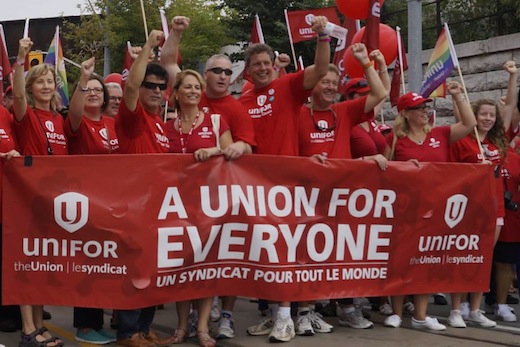
TORONTO – The progressive movement in Canada just gained a giant new ally over Labor Day weekend. Thousands of delegates, representing more than 300,000 workers, convened here to found Unifor, a new union aimed at transforming the labor scene in this country.
Unifor is the result of a merger of two unions, the Canadian Auto Workers (CAW) and the Communications, Energy, and Paperworkers (CEP). It is now the largest private sector union in the country and has within its ranks workers from more than twenty different industries. Activists and leaders of Unifor make clear, however, that this is no ordinary merger. Unifor is upfront about the dire straits that the labor movement finds itself in and about the severity of the challenges working people are facing.
Like in the United States, union density and membership in Canada have been on the decline for decades, down to just 17 percent in the private sector from a high of around 35 percent in the 1970s. Unifor is hoping to initiate struggles that can reverse the assaults of right-wing neoliberal governments and forge a new model of unionism that goes beyond the traditional concerns of safeguarding wages and conditions. While it will of course do all those things unions have always done, Unifor’s founding documents also set out a vision for a more broad-based organization that is solidly integrated into communities and that will have the capacity to reach out to all segments of society.
The new organization is the product of a long discussion process kicked off in January 2012 by the CAW and CEP that analyzed the challenges facing workers and initiated conversations about what a new union might look like. Community chapters are envisioned, which will bring together unionized employees, non-unionized workers, contract employees, retirees, students, the self-employed, the underemployed, and unemployed workers all, as equal members. Outgoing CEP president Dave Coles said the goal is to open the doors of the union to everybody. He said, “We are going to offer membership to people in Canada who have never had the opportunity to be represented, or to have a voice, in labor before.”
The name – Unifor – is intentionally meant to be ambiguous and to allow for a wide vision that can encompass all workers, unlike traditional union names, which list the industries in which their members are employed. It is also meant to be bilingual with the same name in French and English, given that it is to be a Canada-wide union. The name is said to reflect the “values of unity and solidarity, strength and determination, and a modern, forward-looking perspective”, according to leaders. The union wants to become known for the positive and progressive ideas that it is “for” and not allow employers or anti-labor governments to always paint unions as being “against” innovation or efficiency.
Under attack since the 1980s, the labor movement is searching for ways to respond to neoliberal economic policies that have undercut and eliminated the industries where unions once thrived and have consistently attacked the rights of labor in those sectors where unions still survive. These challenges have only intensified in the austerity drives of the current economic crisis, with Conservative politicians in Canada promoting the introduction of U.S.-style ‘right-to-work’ laws and the elimination card-check certification.
With this in mind, Unifor has set expansion as its first priority. A full 10% of revenue, or approximately $10 million initially, will be devoted to organizing workers in non-unionized sectors and workplaces. Newly-elected Unifor President Jerry Dias announced to those gathered at the labor day march that, “Today is really about opportunity, it’s about hope. It’s about us saying we’ve had it and it’s about us saying we’re determined to change the direction of this country.”
The founding document, “A New Union for a Challenging World: Unifor’s Vision and Plan,” and the new organizing policy are available at: http://www.newunionconvention.ca/convention-documents/
Photo: Members of Unifor march in the Labor Day parade (via Unifor Canada/Facebook).










